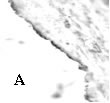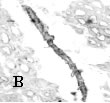| pA2
online © Copyright 2003 The British Pharmacological Society |
022P
University
of Manchester Autumn Meeting September 2003 |
| Endogenous
vasodilator ghrelin and its growth hormone secretagogue receptor 1a
(GHS- R1a) immunocytochemically localize to endothelial cells within
the human vasculature
|
Print Abstract Search PubMed
for: |
Ghrelin, a 28 amino acid peptide possessing a unique functional octanoylation on the Ser3 residue, has been isolated from rat stomach and is the endogenous ligand of the human G-protein coupled GHS-receptor 1a. We have previously demonstrated the presence of high affinity [125I-His9]ghrelin receptors in human cardiovascular tissues (Katugampola et al., 2001). Furthermore, we have shown endothelium-independent vasodilator function for ghrelin in human internal mammary artery (Wiley & Davenport., 2002). The aim of this study was to determine the precise cellular distribution of ghrelin and GHS-R1a in human tissues using antibodies raised against the octanoylated N-terminus of the peptide and a peptidic sequence consisting of amino acids 330 to 366 in the C-terminus of the receptor.
For immunocytochemistry, human tissues were obtained with ethical approval. Left ventricle and atria were from patients transplanted for ischaemic heart disease (n=4), cardiomyopathies (n=3), cystic fibrosis (n=3), or from donor hearts for which there was no suitable recipient (n=3). Sections of histologically normal kidney (n=3) and lung (n=4) were from patients undergoing nephrectomy and lobectomy respectively for non-obstructive carcinomas. Adrenal was from one patient undergoing adrenalectomy for phaeochromocytoma. Human large conduit vessels were from patients undergoing surgery for ischaemic heart disease (n=20). Cryostat sections (30mm) of tissues were fixed in ice-cold acetone for 10 min.
Sections
were blocked with 5% swine serum in phosphate-buffered saline (PBS) for
1h at 23°C and incubated with either an anti-ghrelin (1:300 dilution,
48 hours) or anti-GHS-R1a (1:500 dilution, 96 hours) polyclonal antibody
(Phoenix Pharmaceuticals, CA. USA) in PBS containing 0.01% Tween-20 and
1% swine serum at 4°C. Specific staining was detected using the peroxidase/
anti peroxidase method. Adjacent sections were incubated with non-immune
serum as a negative control.


| A Ghrelin-IR localized to endothelial cells of coronary artery | B GHS-R1a-IR in small myocardial vessels BJGOOUU |
We identified ghrelin-like immunoreactivity (ghrelin-IR) in endothelial cells lining small vessels in myocardium, kidney and lung and in saphenous veins, coronary and radial artery. Its receptor GHS-R1a-IR was localized to coronary artery, left internal mammary artery and saphenous vein endothelial cells and to small blood vessels from myocardium, kidney and adrenal. These findings suggest that, in the human cardiovascular system, ghrelin may act as a locally synthesized vasodilator that elicits its function by activation of GHS-R1a receptors present in small resistance vessels.
MK supported by Isaac Newton and Cambridge European Trusts.
Katugampola,
S.D., Pallikaros, Z. Davenport, A.P. (2001). Br. J. Pharmacol.,134,
143-149.
Wiley, K.E. and Davenport A.P.(2002). Br.J. Pharmacol., 136,1146-1152.